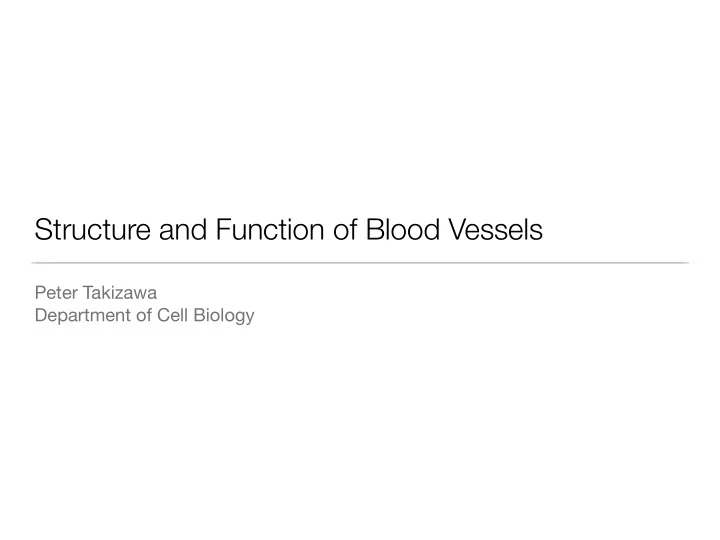

Structure and Function of Blood Vessels Peter Takizawa Department of Cell Biology
What we’ll talk about… • Structure of blood vessels and their appearance in histological samples • Endothelium and structures that control permeability • Increasing endothelial permeability and leukocyte transmigration • Smooth muscle and vascular repair • Angiogenesis
Blood vessels comprise three functional layers.
Endothelial cells perform a variety of structural and biochemical functions. • Permeability • Immune response • Angiogenesis • Modulate vascular resistance • Antihaemostatic and haemostatic control • Enzymatic action on plasma proteins
The aorta is an elastic artery that contains numerous elastic fibers in the media. Intima Adventitia Media Internal Elastic Lamina Endothelial Cell Elastic Fiber Vasa Vasorum Smooth Muscle Cell
Muscular arteries contain more smooth muscle and fewer elastic fibers in the media layer. Intima Adventitia Media Internal Elastic Lamina Endothelial Cell Smooth Muscle Cell External Elastic Lamina
Small muscular arteries contain fewer layers of smooth muscle. Endothelial Cell Smooth Muscle Cell
Arterioles control blood flow into capillaries and create the highest resistance in the circulatory system. Endothelial Cell Smooth Muscle Cell
Arterioles have one or two layers of smooth muscle cells. Smooth Muscle Cell Endothelial Cell
Capillaries contain a single layer of endothelial cells and the occasional pericyte. Pericyte Endothelial Cell Capillary Lumen
Permeability of capillaries
Small molecules and ions diffuse across capillaries but proteins are restricted in most capillaries. Sugars s Small Protein Large Protein
Capillaries restrict the diffusion of protein to maintain oncotic pressure. Protein Protein
Primary components that regulate permeability of capillaries. • Structure of endothelial cells • Basement membrane • Intercellular junctions between endothelial cells • Glycocalyx
Structure of Endothelial Cells
Continuous capillaries contain endothelial cells that only allow passage through intercellular junctions. Pericyte Intercellular Junctions Endothelial Cell
Fenestrated capillaries have endothelial cells with several gaps for diffusion of solutes. Pericyte Fenestrae Endothelial Cell
Discontinuous capillaries contain large pores and lack a basement membrane. Endothelial Cell Fenestrae Lumen
Basement membrane is a negatively-charged barrier on the basal surface of endothelial cells. Basement Membrane Endothelial Cell Red Blood Cell
Junctional complexes restrict paracellular diffusion between endothelial cells. Lumen Lumen Interstium
Glycocalyx restricts diffusion of large, negatively charged molecules. Glycocalyx Glycocalyx Removed
Transcytosis of Proteins
Receptor-mediated endocytosis transports specific proteins across endothelium via transcytosis. Blood Interstitium
Transcytosis mediates movement of proteins across endothelial cells. Intercellular Junction Lumen Endocytic Vesicle Release of Material Interstitium Lumen Release of Material Endocytic Vesicle Interstitium
Increasing the Permeability of Blood Vessels
Inflammatory molecules and immune cells activate signaling pathways that disrupt junctions. Disrupt Junctions Modify Kinases Cadherins Increase Myosin Tension
Thrombin increase vascular permeability through tension on adhesion junctions.
Immune cells must pass across endothelial cells to reach sites of infection.
Leukocyte transmigration consist of three distinct steps. Rolling Adhesion Emigration Timothy Springer Lab, Harvard Medical School
Selectins and integrins mediate rolling and adhesion of immune cells. Selectins Integrins Capture Rolling Arrest Transmigration
Leukocytes disrupt adhesion junctions to migrate across endothelium.
Venules and Veins
Venules have an endothelium and relatively thin layer of smooth muscle. Endothelial Cell Smooth Muscle Cell
Venules have thinner medial layers than arteries and tend to lose their shape. Artery Endothelial Cell Smooth Muscle Cell Venule
The vena cava has a thinner media than the aorta with mostly smooth muscle cells and collagen. Adventitia Media Smooth Muscle Cell Intima
Lymphatic vessels have thin walls and lack red blood cells. Venule Arteriole Endothelial Cell Lymphatic Vessel
Vascular Repair
Damage recruits smooth muscle cell progenitors to the intima. Endothelial Cell Damage Smooth Muscle Cell
Smooth muscle proliferation can lead to occlusion of arteries after insertion of stents.
Angiogenesis
VEGF triggers morphological changes in endothelial tip cells. High O 2 Low O 2
Tip cells follow guidance cues to connect to existing vessels. Semaphorins
Tumor cells initiate angiogenesis to increase their blood supply. VEGF VEGF Tumor cells Stromal cells
Recommend
More recommend